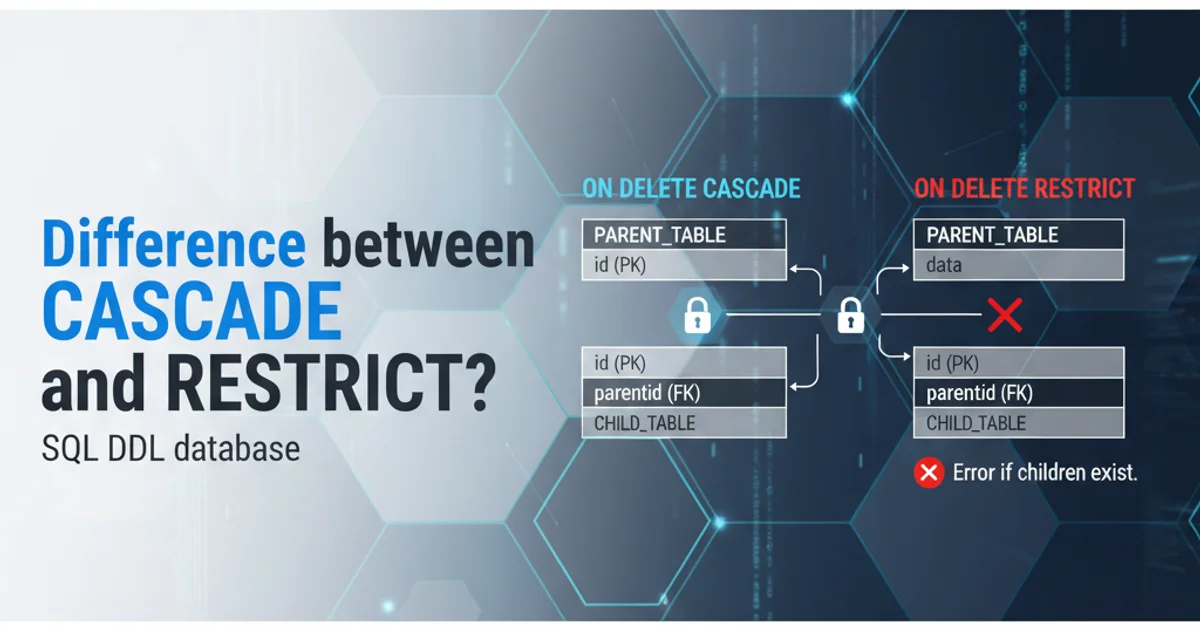Difference between CASCADE and RESTRICT? SQL DDL database
SQL CASCADE vs. RESTRICT: Understanding Referential Integrity Actions

Explore the critical differences between CASCADE and RESTRICT actions in SQL DDL, and learn how they enforce referential integrity in your database schemas.
When designing a relational database, maintaining data consistency and integrity is paramount. Referential integrity, specifically, ensures that relationships between tables remain valid. SQL provides various actions to define how the database should behave when data in a parent table (the one being referenced) is modified or deleted. Two of the most common and often confused actions are CASCADE and RESTRICT.
What is Referential Integrity?
Referential integrity is a property of data that ensures that all foreign key references in a database are valid. This means that if a foreign key in one table refers to a primary key in another table, the referenced primary key must exist. Without referential integrity, you could have 'orphan' records, where a child record points to a non-existent parent, leading to inconsistent and unreliable data.
erDiagram
CUSTOMER ||--o{ ORDER : places
ORDER ||--|{ ORDER_ITEM : contains
PRODUCT ||--o{ ORDER_ITEM : includes
CUSTOMER {
INT CustomerID PK
VARCHAR Name
}
ORDER {
INT OrderID PK
INT CustomerID FK
DATE OrderDate
}
ORDER_ITEM {
INT OrderItemID PK
INT OrderID FK
INT ProductID FK
INT Quantity
}
PRODUCT {
INT ProductID PK
VARCHAR ProductName
DECIMAL Price
}Entity-Relationship Diagram illustrating referential integrity between tables
The RESTRICT Action
The RESTRICT action (or NO ACTION in some SQL dialects, which behaves similarly) is the most conservative approach to enforcing referential integrity. When you define a foreign key with ON DELETE RESTRICT or ON UPDATE RESTRICT, the database will prevent the deletion or update of a parent row if there are any dependent child rows referencing it. This means you must explicitly delete or update all child rows first before you can modify the parent row.
CREATE TABLE Categories (
CategoryID INT PRIMARY KEY,
CategoryName VARCHAR(255)
);
CREATE TABLE Products (
ProductID INT PRIMARY KEY,
ProductName VARCHAR(255),
CategoryID INT,
FOREIGN KEY (CategoryID) REFERENCES Categories(CategoryID) ON DELETE RESTRICT ON UPDATE RESTRICT
);
SQL DDL demonstrating ON DELETE RESTRICT and ON UPDATE RESTRICT
RESTRICT (or NO ACTION) is often the default behavior if no action is specified, it's good practice to explicitly declare it for clarity and to ensure consistent behavior across different database systems.The CASCADE Action
In contrast to RESTRICT, the CASCADE action provides an automatic way to maintain referential integrity. When you define a foreign key with ON DELETE CASCADE or ON UPDATE CASCADE, if a parent row is deleted or updated, the database will automatically delete or update all corresponding child rows. This can be very convenient for managing related data, but it also carries significant risks if not used carefully.
CREATE TABLE Orders (
OrderID INT PRIMARY KEY,
CustomerID INT,
OrderDate DATE
);
CREATE TABLE OrderItems (
OrderItemID INT PRIMARY KEY,
OrderID INT,
ProductID INT,
Quantity INT,
FOREIGN KEY (OrderID) REFERENCES Orders(OrderID) ON DELETE CASCADE ON UPDATE CASCADE
);
SQL DDL demonstrating ON DELETE CASCADE and ON UPDATE CASCADE
CASCADE with extreme caution, especially ON DELETE CASCADE. An accidental deletion of a parent record could lead to the unintended loss of a large amount of related data across multiple tables. Always ensure you fully understand the implications before implementing CASCADE.Choosing Between CASCADE and RESTRICT
The choice between CASCADE and RESTRICT depends entirely on the specific business rules and the desired behavior of your application.
Choose
RESTRICT(orNO ACTION) when:- You want to prevent the deletion or update of parent records if child records exist.
- You need to explicitly manage the deletion/update of child records in your application logic.
- Data loss is a critical concern, and you prefer manual intervention.
- The relationship is such that child records should never exist without a parent.
Choose
CASCADEwhen:- Child records are entirely dependent on the parent and have no meaning without it (e.g., order items without an order).
- You want the database to automatically handle the propagation of changes, reducing application-level code.
- The deletion or update of a parent record should logically result in the deletion or update of its children.
Consider the implications carefully for each foreign key relationship in your schema.